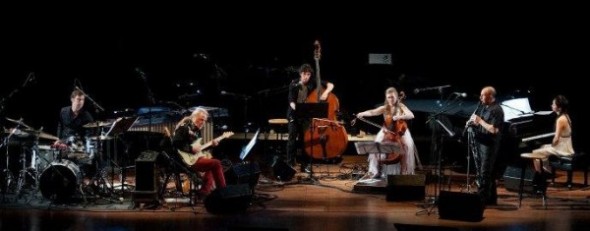Marcel Duchamp’s Fountain of 1917 – his infamous display of a porcelain urinal (signed R Mutt) as a work of art – was the Big Bang of all art that followed. Art could now be Thought and not necessarily Action. That was one powerful pissoir.
American composer John Cage’s ‘4’33’ of 1952 had the same explosive effect on Art Music. But it was a silent explosion, as it consisted of nothing but four minutes and thirty-three seconds of silence – spread over three movements.
Just as Duchamp’s urinal shocked and outraged people because is ‘wasn’t’ Art, ‘4’33’ confounded audiences because it ‘wasn’t’ Music.
But it wasn’t silence, either. Cage intended you to focus on the sounds of the world around you, not masked by the noise of music. It was four minutes and thirty-three seconds of ambient noise, the sounds of the room – your own breathing, a program rustling, a cough.
As part of the Sydney Opera House’s recent John Cage Centenary Celebrations, New York’s Bang On A Can All-Stars presented Ambient Evolution: The Music of John Cage and Brian Eno. Paired with two Cage works was a four-part work by Brian Eno, one-time member of Roxy Music, a Cage acolyte and an innovator of modern ‘ambient’ music.
Another of Cage’s innovations was the ‘prepared’ piano – a piano ‘prepared’ by inserting screws, wires and other dulling or sharpening objects between and around the piano strings. I have heard many recordings of the ‘prepared’ piano, but seeing one played in The Studio of the SOH – by All-Stars pianist Vicky Chow performing excerpts from Cage’s 1948 “Sonatas and Interludes” – was a truly cap-M Modern experience. So much of 20th Century art is taking one thing and re-inventing it as something else, and the ‘prepared’ piano fits that bill perfectly; it looks like a piano but sounds now like a gamelan, now like a tightened drum, now like a plucked koto. Even sometimes like a piano.
Performed beneath huge projections of three of John Cage’s scratchy and opaque watercolour works, “Sonatas and Interludes” and the following piece “Improvisations” were transfixing.
“Improvisations” consisted of duets and silences between electric bass (Robert Black) and snare drum (David Cossin). Each instrument – neither known for its expressive range or timbre – were taken beyond their limits by scratching, pulling, brushing, stopping, starting, until any event became a little universe as time and consciousness contracted.
All very Zen of course; all very Cage.
Guitarist and Bang On A Can co-founder Mark Stewart prefaced their performance of Eno’s “Music For Airports” with a cheerful suggestion that since this music was designed to be ambient music for public spaces – and not to be directly listened to by an audience – we should feel free to get up and stretch or change seats, or move around, as we would if waiting at an airport. Of course, during the full four movements of the work, played by the full six-piece ensemble, no one dared move.
And why would we? “Music For Airports”, or as it was originally called “Ambient 1: Music For Airports” is as lusciously icy and serenely featureless as it was on Eno’s 1978 release. There had never been anything like it (yes, “Music For Airports” was another Big Bang that informed so much that followed: ambient, chill, trance and all its chilled-out children).
Re-imagined for the All-Stars’ piano/synth/clarinet/cello/bass/percussion/guitar ensemble, the work’s long, long tones appeared to stretch time into an elongated ellipse that would come back on itself in slower and slower arcs.
So much so that when, towards the end, clarinetist Ken Thomson offered a scattering of brief and not-too-wild extemporisations, the spell was almost shattered. They seemed to intrude like wind scurries on a broad river, such was the power of Eno’s conception and the All-Stars’ sure hold on this music.
The irony of an audience sitting still, intently listening to every detail of a work that was never intended to be listened to at all, was an irony that would have not been lost on John Cage.
But The Bang On A Can All-Stars’ joy of playing together took this music away from the airless and arid brain space that modern concert music too often inhabits, into a place of play and delight that Cage would have loved.


